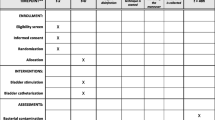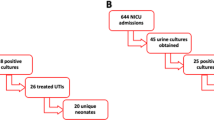Abstract
Background
Methods of urine collection used in precontinent children are a controversial issue. Definitive diagnosis of urinary tract infection (UTI) requires an uncontaminated urine culture. We aimed to describe methods used to collect urine for culture in infants under 3 months of age and compare results and contamination rates.
Methods
This retrospective observational cohort study included 721 urine cultures collected from infants <3 months of age at the Hospital Universitario Infanta Sofía, Madrid, between January 2016 and December 2019. Urine cultures were compared based on collection technique, sex, and patient age.
Results
Median patient age was 36 days and 54.6% were male. In total, 592 (82.1%) samples were collected using clean-catch urine stimulation technique (CCUST), 77 (10.7%) by urethral catheterization (UC) and 52 (7.2%) by urine bag (UB). Positive cultures were obtained in 11.7% (95% confidence interval [CI] 9.1, 14.3) of CCUST samples and in 28.6% (95% CI 18.5, 38.7) of UC samples (p<0.001). The contamination rate was 13.7% (95% CI 10.9, 16.4] for CCUST, 23.1% (95% CI 11.6, 34.6) for UB and 5.2% (95% CI 0.2, 10.2) for UC, with statistically significant differences (p=0.007) between UB and UC collection.
Conclusions
CCUST is the most commonly used method in our hospital for collecting urine in infants younger than 3 months. The contamination rate of UC is lower but not significantly different to that of CCUST. Urine collection by CCUST serves as a non-invasive alternative to UC for diagnosis of UTI in infants under 3 months of age in routine clinical practice.

Graphical abstract
Similar content being viewed by others
Abbreviations
- CCUST:
-
clean-catch urine stimulation technique
- UC:
-
urethral catheterization
- UB:
-
urine bag
- CI:
-
confidence interval
- UTI:
-
urinary tract infection
- IQR:
-
interquartile range
References
Velasco R, Benito H, Mozún R, Trujillo JE, Merino PA et al (2015) Febrile Young Infants with Altered Urinalysis at Low Risk for Invasive Bacterial Infection. A Spanish Pediatric Emergency Research Network’s Study. Pediatr Infect Dis J34:17–21
Diviney J, Jaswon MS (2020) Urine collection methods and dipstick testing in non-toilet-trained children. Pediatr Nephrol. https://doi.org/10.1007/s00467-020-04742-w
Ouellet-Pelletier J, Guimont C, Gauthier M, Gravel J (2016) Adverse Events Following Diagnostic Urethral Catheterization in the Pediatric Emergency Department. CJEM 18:437–442
Lynster CTL, Deepa MN, Pedler SJ, Coulthard MG (2000) Home collection of urine for culture from infants by three methods: survey of parents’ preferences and bacterial contamination rates. BMJ 320:1312–1313
Chia MPL, Shuker INCB, Yen YC, Pillai NK, Yap CG, Jahan NK (2020) Non invasive urine sample in infants: A review paper. Open Access Library J 7:e6946. https://doi.org/10.4236/oalib.1106946
Chandy M, Dewey A, Fogg C, Pilkington K (2020) Non-invasive techniques for stimulating urine production in non-toilet trained children: a systematic review. Emerg Med J 37:162–169. https://doi.org/10.1136/emermed-2019-208580
Kaufman J, Fitzpatrick P, Tosif S, Hoper S, Donath SM, Bryant PA, Babl FE (2017) Faster clean catch urine collection (Quick Wee method) from infants: randomised controlled trial. BMJ 357:j1341. https://doi.org/10.1136/bmj.j1341
Herreros Fernández ML, González Merino N, Tagarro García A, Pérez Seoane B, De la Serna MM, Contreras Abad MT, García Pose A (2013) A new technique for fast and safe collection of urine in newborns. Arch Dis Child 98:27–29
Altuntas N, Celebi Tayfur A, Kocak M, Razi HC, Akkurt S (2014) Midstream clean-catch urine collection in newborns: a randomized controlled study. Eur J Pediatr 174:577–582
Labrosse M, Levy A, Autmizguine J, Gravel J (2016) Evaluation of a New Strategy for Clean-Catch Urine in Infants. Pediatrics 138:e20160573–e20160573
Tran A, Fortier C, Giovannini-Chami L, Demonchy D, Caci H, Desmontils J, Montaudie-Dumas I, Bensaïd R, Haas H, Etienne B (2016) Evaluation of the bladder stimulation technique to collect midstream urine in infants in a pediatric emergency department. PLoS One 11:e0152598
Herreros ML, Tagarro A, García-Pose A, Sánchez A, Cañete A, Gili P (2015) Accuracy of a new clean-catch technique for diagnosis of urinary tract infection in infants younger than 90 days of age. Paediatr Child Health 20:e30–e32
Herreros ML, Tagarro A, García-Pose A, Sánchez A, Cañete A, Gili P (2018) Performing a urine dipstick test with a clean-catch urine sample is an accurate screening method for urinary tract infections in young infants. Acta Paediatr 107:145–150
Roberts KB, Wald ER (2018) The diagnosis of UTI: Colony count criteria revisited. Pediatrics 141:e20173239
Finnell SM, Carroll AE, Downs SM (2011) Technical report - Diagnosis and management of an initial UTI in febrile infants and young infants. Pediatrics 128:749–770
Roberts KB, Downs SM, Finnell SM, Hellerstein S, Shortliffe LD, Wald ER, Zerin JM, Okechukwu K (2016) Reaffirmation of aap clinical practice guideline: The diagnosis and management of the initial urinary tract infection in febrile infants and young infants 2-24 months of age. Pediatrics 138:e20163026
Robinson JL, Finlay JC, Lang ME, Bortolussi R, Canadian Paediatric Society, Infectius Diseases and Immunization Committee, Community Paediatrics Committee (2014) Urinary tract infections in infants and infants: diagnosis and manegement. Paediatr Child Health 19:315–319
Grupo de trabajo de la Guía de Práctica Clínica sobre Infección del Tracto Urinario en la Población Pediátrica. Guía de Práctica Clínica sobre Infección del Tracto Urinario en la Población Pediátrica. Plan de Calidad para el Sistema Nacional de Salud del Ministerio de Sanidad, Política Social e Igualdad. Instituto Aragonés de Ciencias de la Salud; 2011. Guías de Práctica Clínica en el SNS: I+CS No 2009/01
American Academy of Pediatrics (AAP) Committee on Quality Improvement, Subcommitte on Urinary Trac Infection (1999) The Diagnosis, Treatment, and Evaluation of the Initial Urinary Tract Infection in Febrile Infants and Young Infants. Pediatrics 103:843–852
Shaikh N, Morone NE, Bost JE, Farrell MH (2008) Prevalence of urinary tract infection in childhood: a meta-analysis. Pediatr Infect Dis J 27:302–308
Velasco R, Benito H, Mozun R, Trujillo JE, Merino PA, De La Torre M, Gomez B, Mintegi S, Group for the Study of Febrile Infant of the RiSEUP-SPERG Network (2016) Importance of urine dipstick in evaluation of young febrile infants with positive urine culture a Spanish pediatric emergency research group study. Pediatr Emerg Care 32:851–855
Tosif S, Baker A, Oakley E, Donath S, Babl FE (2012) Contamination rates of different urine collection methods for the diagnosis of urinary tract infections in young infants: An observational cohort study. J Paediatr Child Health 48:659–664
Alam MT, Coulter JB, Pacheco J, Correia JB, Ribeiro MG, Coelho MF, Bunn JE (2005) Comparison of urine contamination rates using three different methods of collection: Clean-catch, cotton wool pad and urine bag. Ann Trop Paediatr 25:29–34
Altuntas N, Alan B (2019) Midstream Clean-Catch Urine Culture Obtained by Stimulation Technique versus Catheter Specimen Urine Culture for Urinary Tract Infections in Newborns : A Paired Comparison of Urine Collection Methods. Med Princ Pr 29:326–331
Phillips B (2009) Towards evidence based medicine for paediatricians. Urethral catheter or suprapubic aspiration to reduce contamination of urine samples in young infants? Arch Dis Child 94:736–739
Karacan C, Erkek N, Senel S, Akin Gunduz S, Catli G, Tavil B (2010) Evaluation of Urine Collection Methods for the Diagnosis of Urinary Tract Infection in Infants. Med Princ Pract 19:188–191
Mulcrone AE, Parikh M, Ahmad FA (2020) Reducing infant catheterization in the emergency department though clean-cathch urine collection. J Am Coll Emerg Physicians Open 1:1533–1541. https://doi.org/10.1002/emp2.12211
Kaufman J, Knight AJ, Bryant PA, Babl FE, Dalziel K (2020) Liquid gold: the cost-effectiveness of urine simple collection methods for young precontinent infants. Arch Dis Child 105:253–259
Acknowledgements
The authors thank Kenneth McCreath for editing the manuscript.
Funding
The authors received no external funding for this manuscript.
Author information
Authors and Affiliations
Contributions
Dr. M.L. Herreros: 1) Substantial contributions to the conception, design of the work, and the acquisition, analysis or interpretation of data; 2) Drafting the work and revising it critically; 3) Final approval of the version published; and 4) agreement to be accountable for all aspects of the work.
Dr. P. Gili: 1) Substantial contributions to the conception, design of the work, analysis and interpretation of data; 2) drafting the work and revising it critically; 3) Final approval of the version published; and 4) agreement to be accountable for all aspects of the work.
Dr. R. del Valle, Dr. M. Pacheco and Dr. A. Barrios: 1) Substantial contributions to the acquisition, analysis and interpretation of data; 2) drafting the work and revising it critically; 3) final approval of the version published; and 4) agreement to be accountable for all aspects of the work.
Dr. Aida Sánchez: 1) Substantial contributions to the conception and design of the work, and the acquisition, analysis and interpretation of data; 2) drafting the work and revising it critically; 3) final approval of the version published; and 4) agreement to be accountable for all aspects of the work.
Corresponding author
Ethics declarations
Ethics approval
Hospital Universitario Infanta Sofía Research Commission number 12/05/2020
Conflict of interest
The authors declare no competing interests.
Additional information
Publisher’s note
Springer Nature remains neutral with regard to jurisdictional claims in published maps and institutional affiliations.
Supplementary Information
ESM 1
(PPTX 62 kb)
Rights and permissions
About this article
Cite this article
Herreros, M.L., Gili, P., del Valle, R. et al. Urine collection methods for infants under 3 months of age in clinical practice. Pediatr Nephrol 36, 3899–3904 (2021). https://doi.org/10.1007/s00467-021-05142-4
Received:
Revised:
Accepted:
Published:
Issue Date:
DOI: https://doi.org/10.1007/s00467-021-05142-4




